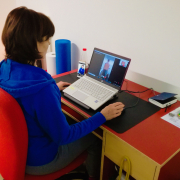Telephysiotherapy in Isico: the published research
In this pandemic year a lot has changed in our daily habits, much in the way we work. Something also in the way we treat patients. We had to adapt to take opportunities from difficulties. In Isico, we have done this from the beginning, overcoming the first phase of closures thanks to the online mode of medical visits and physiotherapy treatments.
It was a way not to leave our patients alone and not to waste the efforts made, a way that after some time has become an integral part of our therapeutic proposal.
We learnt a lot and this also translated into the research, published recently by the Spine Journal, “Lessons learnt in two months of the exclusive application of telephysiotherapy instead of classical physiotherapy during the lockdown in Italy“.
“Current evidence on telemedicine mostly refers to interventions not requiring hands-on approaches, based on either technology or oral/visual interactions – explains Michele Romano, director of Isico physiotherapy and author of the research – In a way, the pandemic offered a sudden push to telemedicine. The question is which lessons can we learn on telephysiotherapy after a few months of extensive and mandatory experience?”
For this reason, we want to share the experiences of exclusively telephysiotherapy treatments acquired by 38 physiotherapists working for Isico during the 2 months of lockdown from March 16th to May 11th.
It was crucial in the first phase that patients accept telephysiotherapy. Usually, the appointments are managed by the booking call-center, but after the first phone calls it was clear that this unusual and unexpected change proposed by a secretary was not well received by the patients.
Consequently, the new standard is that the appointment is made by phone call by the treating physiotherapist him/herself. That facilitates the interaction with the patient, and allows to professionally answer all eventual doubts.
How to organise to be able to carry out physiotherapy treatments online? “An involvement of caregivers and families is necessary for the session. A free video-communication App is used (Skype or Meet) – explains Michele Romano – Evaluation results autonomously collected by patients with the help of a caregiver, are sent before the session to fill the assessment form in advance. One caregiver is present during the session, with one camera to film the patient, to help correct mistakes and observe the right execution of specific exercises; a second device is used for the Institute App to record the exercises”.
During 2 months of lockdown, telephysiotherapy sessions have been 2,239 (100%). After the lockdown, when back to “normal” were face-to-face hands-on physiotherapy, 10% (532 out of a total of 5,091) remained telephysiotherapy sessions.
“The common feeling of patients and their caregivers was of not having been abandoned – explains Michele Romano – during these months we verified that the systems work properly, now this wide and sudden experience is available for the worldwide physiotherapy community. Telephysiotherapy is a not so difficult, readily available instrument.“
Obviously, limits and drawbacks referred by physiotherapists and patients included the impossibility to use hands-on, the need to simplify the approach, the limited attention of younger patients, the connection difficulties.
Most physiotherapists and patients agreed that this type of approach is perfect in emergency, but it cannot substitute normal physiotherapy sessions in normal times.
“Yet we have found – concludes Michele Romano – that there is a group of patients who have discovered telemedicine and continue to use it even now, an additional opportunity that therefore in Isico we have decided to offer patients in the future, alongside the classical medical visits and physiotherapy treatments performed in-person.”

